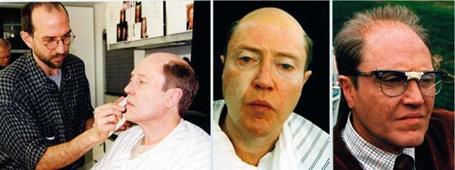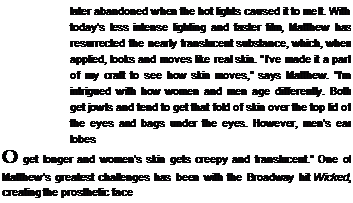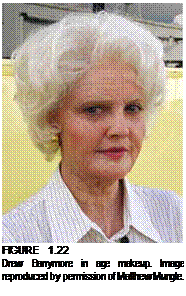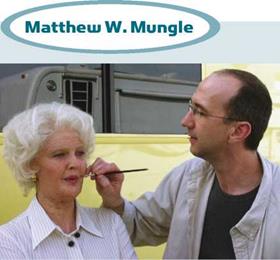In the application of makeup and makeup effects it is critical for you, the makeup artist, to be aware of the potential for cross-contamination of makeup and accessories. Infections such as cold sores, sties, and any number of other potentially more harmful bacterial or viral infections can be transmitted via makeup sponges, powder puffs, foundations, creams, lipstick, eyeliner, and so on. These can also be passed on via brushes and other tools that have not been cleaned or sterilized properly. Portable autoclaves for sterilizing brushes, scissors, sponges, and other tools of the trade can be purchased for less than $300. Because of this potential for contamination and because the acids in your skin could also be contaminants, you should never touch makeup products with your bare hands. Use brushes, sponges, or spatulas instead. Bulk applicator items can be purchased relatively inexpensively for just such purposes.
In the United States you can obtain health and safety regulations from the Occupational Safety and Health Administration, or OSHA (www. osha. gov); in the United Kingdom and Europe, Health and Safety Executive, or HSE, publishes the Control of Substances Hazardous to Health (COSHH) Regulations 2002 (www. hse. gov. uk/coshh). In particular, you should be familiar with the correct storage and use of cleaning agents, solvents, polymers, and the like and make certain that the storage areas are clearly marked and in compliance with your local health and safety regulations.
The tools and materials we work with are not toys. Fatalities have been known to result from improper use and storage of numerous tools and chemicals common to the creation of special makeup effects. Thankfully, that number is small. Virtually every product used in the course of fabricating makeup effects has a product Material Safety Data Sheet (MSDS) with a product overview and recommended safety precautions. In fact, MSDS information should be gathered and stored on all materials (if available) a makeup artist uses. These sheets are required when an OSHA representative requests them. Keeping them handy and in your kit, particularly when you are traveling, may actually minimize potential hassles with TSA or other security folks regarding what is in your kit and whether or not it may still be in your kit when you reach your destination.
There are enough harmful agents wafting through our daily environments already without adding to our potential health risks. Work only in areas with adequate ventilation. Buy particle masks and a respirator capable of filtering not only dust particles (even mist from airbrushed makeup foundation is not good to breathe) but toxic fumes as well, such as acetone and naphtha. Purchase boxes of disposable gloves in powder-free latex, vinyl, and nitrile. Get in the habit of wearing safety glasses. Many of the substances we can come into contact with might not be immediately harmful, but harmful levels can build up cumulatively in your system over time. Take sensible precautions and keep both your workshop and makeup room safe and clean and yourself healthy.
![]()
The products in your kit should be properly labeled to avoid mistaking acetone for astringent. Hazardous materials should be kept securely in lockable metal cabinets or cases. It really is easy to work safely and hygienically if you simply use common sense.
|
FIGURE 1.20 Matthew doing finals on Drew Barrymore for Charlie’s Angels: Full Throttle. Image reproduced by permission of Matthew Mungle. |
Academy Award winner Matthew W. Mungle is regarded as one of Hollywood’s premier makeup special effects artists. He has over 100 film and television projects to his credit, including The Bucket List, Schindler’s List, Ghosts of Mississippi, Bram Stoker’s Dracula, Edward Scissorhands, Six Feet Under, N. C.I. S., House, TheX Files, CSI, and Women’s Murder Club. Matthew has earned accolades and recognition as one of the industry’s top masters of special makeup effects. Along with Neill Gorton, Matthew has had an enormous influence on my career and mentored me through my first feature as a makeup department head and makeup effects supervisor. I credit much of what I know to what Matthew taught me.
As a boy Matthew recalls seeing Frankenstein, Dracula, and The Mummy. He was fascinated with the makeup, often “borrowing” his mother’s cosmetics to create his own version of horror. As he got older, he sent away for theatrical
makeup from New York and Dallas specialty stores—and experimented with face casts and prosthetics on willing family members and friends. Although his parents thought it was a phase he would soon outgrow, Matthew knew differently. He credits the 1964 release of The Seven Faces of Dr. Lao, with makeup effects on Tony Randall by the late William Tuttle, as having been his greatest influence and deciding factor in becoming a special effects makeup artist.
Matthew came to Hollywood in 1977 and in 1978 applied to and was accepted into Joe Blasco’s Make-up Center, one of Hollywood’s top makeup academies that is responsible for training many of the film and television industry’s best makeup artists. Matthew credits Joe with his professional start in the industry. “I was a sponge, absorbing every ounce of knowledge I could,” he said. “Whether learning the techniques of beauty makeup or casting molds and working with prosthetics, I wanted to be as versatile as I could.” Today Matthew is a veteran voice listened to by up-and – coming artists hoping to find their own niche in the industry. Matthew says, “If you want to be a working makeup artist, you need to learn and perfect all areas of the craft.”
Matthew’s professional career began on low-budget projects that taught him to think quickly on his feet. His first major success was on Edward Scissorhands in 1990. Years later, Matthew has accumulated an impressive list of credits and an equally impressive genre of box office successes, including an Academy Award and two other nominations, as well as several Emmy Awards and continued international recognition.
Age makeup has become one of Matthew’s strongest calling cards and an area of makeup effects that’s definitely challenging. His fascination with artificially making someone young look old prompted him to research more viable methods, such as gelatin, first used in the 1930s but
|


 masks for the production’s various characters. Balancing his film and TV projects, Matthew continues his work for the show’s Broadway, U. S. tour, Japan, and Los Angeles productions.
masks for the production’s various characters. Balancing his film and TV projects, Matthew continues his work for the show’s Broadway, U. S. tour, Japan, and Los Angeles productions.
During a rare lull in an always hectic schedule, I asked Matthew what advice he’d give someone with a desire to begin a career in special makeup effects.
TD: What advice would you give someone with little or no experience with special makeup effects to begin studying?
MM: Read as much as you can about makeup effects on the Internet and from books. Practice taking face casts, sculpting, mold making, and application of prosthetics as much as you can. Attend a makeup school, if possible. You can always learn from others, whether their techniques are time-tested or cutting-edge new.
TD: When designing a character makeup, what are important considerations to take into account?
MM: Where the character lives and the environment around them; for instance, if a person was in a cave for a long time, their skin would be very pale and translucent. How this character will move and the facial expressions they’ll make are important. Most of all, how anatomically correct the facial features have to be.
TD: What is the most important skill or skills a makeup effects artist must possess?
MM: The ability to get along with actors and other crew members!
TD: What should be in a makeup effects portfolio?
MM: Beauty makeups, small and large prosthetic appliances, character and old-age makeups with and without prosthetics, and creature prosthetic makeups.
Matthew’s process of fabricating bondo appliances—a combination of Pros-Aide® adhesive, Cab-O-Sil® filler and added coloring—has taken off in a big way since Christien Tinsley’s success in creating 3D wound appliance transfers for The Passion of the Christ. The extremely soft bondo encapsulated in Matthew’s alcohol-based “Soft Sealer” skinned prosthetics makes them ideal f-or use as a small to medium-sized prosthetic; he created eye bruises for Sly Stallone in Rocky 6, casualty wounds for Poseidon, and even an upper lip appliance supplied for Guy Pearce as Andy Warhol in Factory Girl. These appliances are great for actors who perspire a lot or have to be wet all day and are extremely easy to apply with the lightest touch of 99% alcohol.
MM: There has been a lot of use of New-Baldies® plastic-skinned Plat-Sil gel-filled silicone appliances in the last couple of years. Thanks to Ryan McDowell, we have had great success making silicone appliances with the New-Baldies skin and filled with Plat – Sil Gel 10 platinum-based silicone, which has a very low leach property when highly plasticized. However, I feel in the right circumstance that gelatin, foam latex, and even bondo appliances still have their place in our great world of creative makeup effects.
Matthew is big on not limiting himself to one particular material for casting appliances.
MM: I use all materials because they each have their own different properties. I try not to limit myself to a certain material because of the outcome of the creation.

